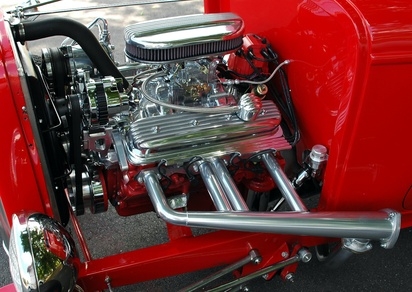
The Chevrolet 350 has long been known as a versatile powerhouse, capable of powering anything from tow trucks to 300mph land-speed racers. The 350 is part of Chevrolet's seminal small-block family of pushrod V-8s that have been in service for over 50 years. The small block's long service life and architectural versatility means that it's possible to build a reliable-but-tire-shredding hauler from almost nothing but factory parts. While you could install the crankshaft from a 400 small block into a 350 engine block to create an all-factory 383, modern aftermarket parts engineered for the task cost about the same and will generally perform better.
Begin with an L31 truck engine (aka Vortec 5700) from a 1996 to 2003 Chevrolet Express/GMC Sierra van, 1996 to 1999 Chevrolet C/K truck or SUV or a 1999 to 2000 Cadillac Escalade. The L31 was the last and most advanced "traditional" small block produced before GM replaced it with the LS series. The L31 is an LT (second-generation) small block, meaning that most of the parts will cross over from traditional engines. However, its reverse-flow cooling system and advanced cylinder heads make it a far better starting point.
Purchase an aftermarket stroker kit with a 3.75-inch crankshaft, powdered-metal connecting rods and hypereutectic (silicon alloy) pistons designed to yield a 10-to-1 compression ratio with a 64-cc combustion chamber. Coat the tops of the pistons, the combustion chamber roofs and the inside of the intake/exhaust ports with thermally insulating ceramic powdercoating. This coating will help to contain heat inside the combustion chambers, where it can make power instead of allowing it to leach into the cooling system as waste.
Install the stroker rotating assembly, using a die-grinder to clearance the block around the rods and crankshaft counterweights as necessary. Remove only enough material to leave 1/8- to 1/4-inch clearance around the assembly. Install a windage tray to keep oil off of the crankshaft, and install the cylinder heads.
Install a set of 1.6-to-1 roller rocker arms in place of the stock 1.5-to-1 arms. These slightly longer rocker arms will open the valves about 6.5 percent further than the stock units, allowing you to utilize the stock camshaft to help compensate for the 9.5-percent increase in displacement.
Install a 52-mm throttle body in place of the stock 48-mm unit to match the intake manifold's 52-mm hole. The stock 19 pounds-per-hour fuel injectors are only capable of safely supporting about 275 horsepower -- any higher and you run the risk of running lean and frying the motor. Consider upgrading to 28 to 30 pounds-per-hour injectors and at least a 180 liter-per-hour fuel pump. All of this will require computer retuning, but should be within the parameters of the stock GM computer.